The Primary Hyperoxaluria Treatment Market is estimated to be valued at USD 48.4 billion in 2025 and is projected to reach USD 110.5 billion by 2035, registering a compound annual growth rate (CAGR) of 8.6% over the forecast period.
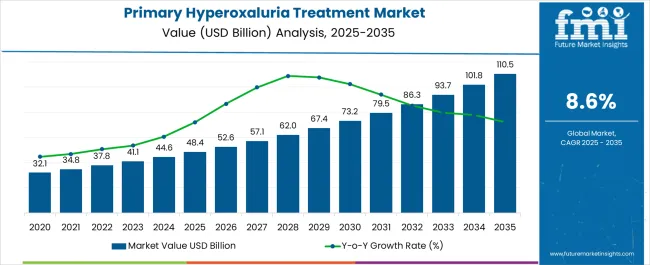
| Metric | Value |
|---|---|
| Primary Hyperoxaluria Treatment Market Estimated Value in (2025 E) | USD 48.4 billion |
| Primary Hyperoxaluria Treatment Market Forecast Value in (2035 F) | USD 110.5 billion |
| Forecast CAGR (2025 to 2035) | 8.6% |
The primary hyperoxaluria treatment market is expanding steadily due to rising diagnosis rates, growing awareness among healthcare providers, and the introduction of novel therapeutic approaches targeting rare metabolic disorders. Advances in genetic testing have improved early detection, supporting timely intervention and better patient outcomes.
Increasing investment in orphan drug development and regulatory incentives are encouraging pharmaceutical companies to accelerate research in this field. Patient advocacy groups and global healthcare initiatives are also playing a critical role in promoting access to therapies and expanding treatment adoption across developed and emerging regions.
The future outlook remains positive as healthcare systems prioritize innovation, affordability, and accessibility in rare disease management, creating opportunities for advanced drugs and diversified delivery mechanisms in the treatment landscape.
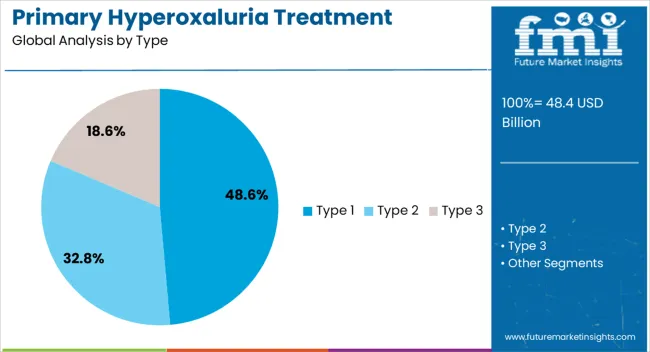
The type 1 segment is expected to account for 48.60% of market revenue by 2025, positioning it as the leading category within the type classification. Its dominance is linked to the higher prevalence of type 1 primary hyperoxaluria compared with other forms, resulting in a greater clinical demand for targeted therapies.
Early onset and severe progression patterns associated with this type have driven stronger medical attention and treatment focus.
Continued research in gene therapies and disease modifying drugs further reinforces its significance, making type 1 the cornerstone segment of the overall market.
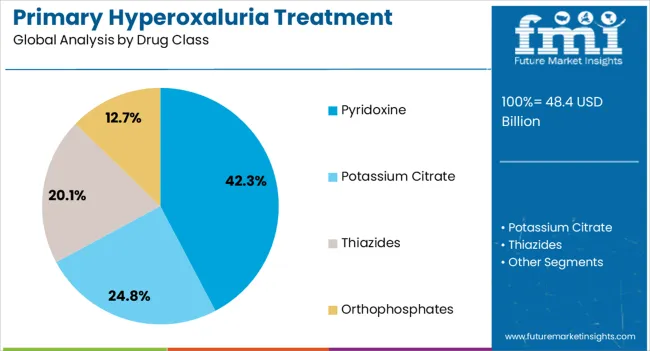
The pyridoxine drug class segment is projected to hold 42.30% of market revenue by 2025, establishing it as the most prominent drug class. This growth is being fueled by its effectiveness in reducing oxalate levels in a subset of patients with type 1 primary hyperoxaluria.
Its established clinical use, affordability, and availability have made it the preferred first line treatment in several regions. Widespread adoption has been further encouraged by strong physician familiarity and the ability to manage disease progression in responsive patients.
These factors have ensured pyridoxine’s position as the dominant therapeutic option within the drug class segment.
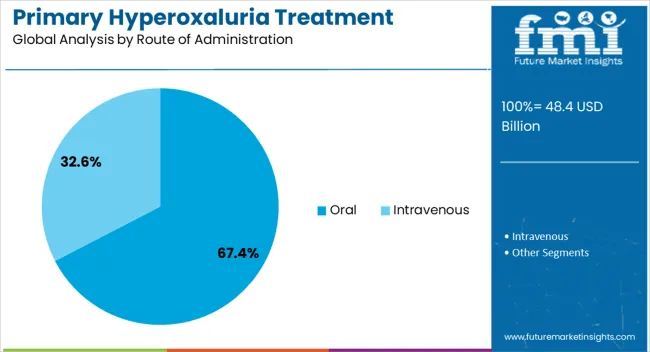
The oral route of administration segment is anticipated to contribute 67.40% of market revenue by 2025, making it the most significant segment. Preference for oral formulations is driven by patient convenience, higher compliance rates, and cost effectiveness in long term therapy.
Oral drugs simplify treatment regimens, reduce the need for hospital visits, and align with the growing focus on home based disease management. As most first line therapies for primary hyperoxaluria are delivered orally, this route has become the standard across healthcare systems.
These advantages continue to reinforce the leadership of the oral route of administration in the market.
According to market research and competitive intelligence provider, Future Market Insights- the market for Primary Hyperoxaluria Treatment reflected a value CAGR of 5.2% during the historical period, 2020 to 2025.
One of the key drivers of market growth is the increasing prevalence of primary hyperoxaluria. While the condition is rare, its incidence has been steadily increasing in recent years, which is expected to drive demand for effective treatments.
The approval of Lumasiran in 2024 has also been a major boost to the market, as it represents the first targeted therapy for primary hyperoxaluria type 1. The drug has shown promising results in clinical trials, and its approval is expected to drive further research and development in the field.
In addition, the growing focus on precision medicine and personalized treatments is expected to drive innovation in the primary hyperoxaluria treatment market. With the increasing availability of genetic testing and personalized medicine, there is an opportunity to develop targeted therapies that are tailored to individual patients' genetic profiles.
The primary hyperoxaluria treatment market is expected to continue to grow in the coming years as new treatments are developed and approved, and as the demand for effective therapies for this rare disease continues to increase. Overall, the market for Primary Hyperoxaluria Treatment is expected to register a CAGR of 8.6% in the forecast period ranging from 2025 to 2035.
Increasing Prevalence of Primary Hyperoxaluria to push market growth
The increasing prevalence of primary hyperoxaluria is expected to be a significant driver of market growth in the primary hyperoxaluria treatment market. While the condition is considered rare, its incidence has been steadily increasing in recent years.
Primary hyperoxaluria is a genetic disorder that affects the liver's ability to metabolize oxalate, which can lead to the formation of kidney stones and progressive kidney damage. According to the National Institutes of Health (NIH), the estimated prevalence of primary hyperoxaluria ranges from 1 in 100,000 to 1 in 1,000,000 individuals worldwide.
However, recent studies have suggested that the actual prevalence of the condition may be higher than previously thought. For example, a study published in the American Journal of Kidney Diseases in 2020 estimated that the incidence of primary hyperoxaluria in the United States is closer to 1 in 45,000 individuals.
As the prevalence of primary hyperoxaluria continues to increase, there is likely to be greater demand for diagnosis and treatment of the condition, which is expected to drive growth in the primary hyperoxaluria treatment market. In addition, as more people are diagnosed with the condition, there is likely to be greater interest and investment in research and development of new treatments, which could further boost market growth.
Overall, the increasing prevalence of primary hyperoxaluria is expected to be a significant driver of market growth, as it is likely to lead to greater demand for effective treatments and increased investment in the development of new therapies.
Expensive Cost of Treatment to restrict Market Growth
One of the significant challenges faced by the PKU therapeutics market is the lack of awareness and underdiagnosis of the disorder. Primary hyperoxaluria is a rare disease, and as a result, there is limited awareness of the condition among healthcare providers and the general public. This can lead to delays in diagnosis and treatment, which can negatively impact patient outcomes.
Moreover, developing new treatments for rare diseases such as primary hyperoxaluria can be challenging, as the regulatory environment can be complex and uncertain.
This can lead to delays in bringing new therapies to market. Overall, while there have been some recent advances in the primary hyperoxaluria treatment market, there are still several challenges that need to be addressed to improve patient outcomes and ensure the development of more effective and accessible treatments.
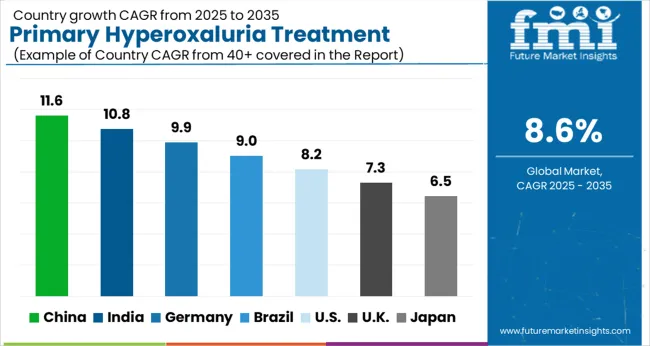
Increasing awareness and diagnosis of the condition Shaping Landscape for Primary Hyperoxaluria Treatment in South & East Asia
The primary hyperoxaluria treatment market is still developing in the South & East Asia region, and there is limited data available on the prevalence and treatment of the condition in the region. However, there have been some recent developments that suggest that the market is starting to grow in this region.
For example, in 2024, the pharmaceutical company Alnylam Pharmaceuticals announced that its drug Lumasiran, the first targeted therapy for primary hyperoxaluria type 1, had received regulatory approval in Japan.
This was a significant development, as Japan is a major market in the South & East Asia region and has a well-established healthcare system. The approval of Lumasiran in Japan is likely to increase awareness of primary hyperoxaluria in the region and could lead to greater demand for diagnosis and treatment of the condition.
In addition, there have been some recent studies that suggest that the prevalence of primary hyperoxaluria may be higher in certain parts of the South & East Asia region than previously thought.
For example, a study published in the Journal of the American Society of Nephrology in 2024 found that the prevalence of primary hyperoxaluria type 1 was higher in parts of India than previously reported. This suggests that there may be a significant unmet need for primary hyperoxaluria treatment in the region.
Overall, while the primary hyperoxaluria treatment market is still developing in the South & East Asia region, recent developments suggest that there is growing interest and investment in this area. As awareness of the condition increases and more effective treatments become available, it is likely that the market will continue to grow in the region.
Increasing Focus on Technological Advancements shaping Landscape for Primary Hyperoxaluria Treatment in North America
The market for primary hyperoxaluria treatment in North America is expected to grow due to several factors. One of the primary drivers of market growth is the relatively high prevalence of primary hyperoxaluria in the region, particularly primary hyperoxaluria type 1.
According to the National Institutes of Health (NIH), the estimated prevalence of primary hyperoxaluria type 1 in the United States is approximately 1 in 100,000 individuals. This high prevalence of the condition is expected to drive demand for effective treatments in the region.
Another factor that is contributing to market growth in North America is the increasing awareness and diagnosis of primary hyperoxaluria. There is growing recognition of the condition among healthcare professionals, which is leading to more accurate diagnosis and treatment of the condition.
This is particularly true for primary hyperoxaluria type 1, which is often diagnosed in childhood. As more people are diagnosed with the condition, there is likely to be greater demand for effective treatments.
Advances in the development of treatments for primary hyperoxaluria are also driving market growth in North America. Lumasiran, a drug that targets the underlying genetic cause of primary hyperoxaluria type 1, was approved by the USA Food and Drug Administration (FDA) in 2024. This has LED to greater interest and investment in the development of new therapies, which is expected to boost market growth.
In addition, favorable reimbursement policies in North America are making primary hyperoxaluria treatment more accessible to patients. For example, kidney transplantation, which is a treatment option for some patients with end-stage renal disease caused by primary hyperoxaluria, is typically covered by insurance in North America. This makes it easier for patients to access the treatment they need.
Finally, North America has a strong healthcare infrastructure that is able to support the development and delivery of new treatments for primary hyperoxaluria.
This includes specialized centers for the treatment of rare diseases, which can provide comprehensive care for patients with the condition. The strong healthcare infrastructure in North America is expected to contribute to continued growth in the primary hyperoxaluria treatment market in the region.
Overall, the combination of high prevalence, increasing awareness and diagnosis, advances in treatment options, favorable reimbursement policies, and a strong healthcare infrastructure is expected to drive growth in the primary hyperoxaluria treatment market in North America.
Parenteral route of administration to hold a significant share and push market growth
The injectable route of administration is likely to account for a significant share of the Primary Hyperoxaluria Treatment market. Currently, the only approved therapy for the treatment of primary hyperoxaluria is Lumasiran, which is administered via subcutaneous injection. Therefore, the subcutaneous injection route of administration is expected to account for a significant share of the primary hyperoxaluria treatment market.
However, there are also other therapies currently in development for the treatment of primary hyperoxaluria that may use different routes of administration. For example, some gene therapy approaches are being developed that would involve the delivery of a therapeutic gene via a viral vector. These therapies may use an intravenous infusion or other routes of administration. Overall, while the subcutaneous injection route of administration is currently dominant in the primary hyperoxaluria treatment market, the development of new therapies may lead to the use of different routes of administration in the future.
Hospital pharmacies segment to hold a significant share and push market growth
Hospitals and specialty clinics are often the first point of contact for patients with Primary Hyperoxaluria, as they provide specialized care and access to diagnostic tools and treatments. These facilities also have the expertise and resources to provide comprehensive care to patients with complex or severe cases of Primary Hyperoxaluria.
In addition, many of the treatments for Primary Hyperoxaluria require specialized administration or monitoring, such as intravitreal injections or electroretinography testing, which are typically performed in hospitals or specialty clinics. This further contributes to the dominance of these distribution channels in the Primary Hyperoxaluria Treatment market.
Overall, hospitals and specialty clinics are likely to continue to account for a significant share of the Primary Hyperoxaluria Treatment market, driven by the specialized care and expertise they provide. However, as patient preferences and healthcare delivery models continue to evolve, the market share of the various distribution channels may shift over time.
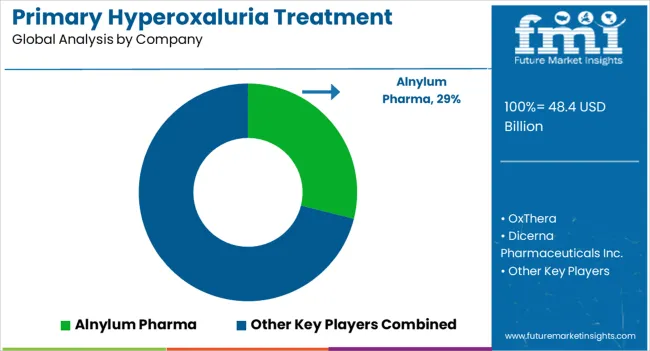
Key players in the market include companies such as Competition Deep Dive, Alnylum Pharma, OxThera, Dicerna Pharmaceuticals, Inc., Allena Pharmaceuticals, Biocodex, Tecoland Corporation, Zhejiang Tianxin Pharmaceutical Co., Takeda Pharmaceuticals, Wuxi Further Pharmaceutical Co Ltd, Genentech, along with healthcare providers and technology companies among other global players.
| Report Attribute | Details |
|---|---|
| Market Value in 2025 | USD 18 million |
| Market Value in 2035 | USD 41.07 million |
| Growth Rate | CAGR of 8.6% from 2025 to 2035 |
| Base Year for Estimation | 2025 |
| Historical Data | 2020 to 2025 |
| Forecast Period | 2025 to 2035 |
| Quantitative Units | Revenue in USD Million and CAGR from 2025 to 2035 |
| Report Coverage | Revenue Forecast, Volume Forecast, Company Ranking, Competitive Landscape, Growth Factors, Trends, and Pricing Analysis |
| Segments Covered |
Type, Route of Administration, Distribution Channel, Drug Class, Region |
| Regions Covered |
North America; Latin America; Europe; South Asia; East Asia; Oceania; Middle East & Africa |
| Key Countries Profiled | United States, Canada, Brazil, Mexico, Germany, United Kingdom, France, Spain, Italy, Malaysia, Singapore, India, Thailand, China, Japan, South Korea, Australia, New Zealand, GCC Countries, South Africa, Israel |
| Key Companies Profiled |
Alnylum Pharma; OxThera; Dicerna Pharmaceuticals Inc.; Allena Pharmaceuticals; Biocodex; Tecoland Corporation; Zhejiang Tianxin Pharmaceutical Co.; Takeda Pharmaceuticals; Wuxi Further Pharmaceutical Co Ltd; Genentech |
| Customization | Available Upon Request |
The global primary hyperoxaluria treatment market is estimated to be valued at USD 48.4 billion in 2025.
The market size for the primary hyperoxaluria treatment market is projected to reach USD 110.5 billion by 2035.
The primary hyperoxaluria treatment market is expected to grow at a 8.6% CAGR between 2025 and 2035.
The key product types in primary hyperoxaluria treatment market are type 1, type 2 and type 3.
In terms of drug class, pyridoxine segment to command 42.3% share in the primary hyperoxaluria treatment market in 2025.
Explore Similar Insights

Thank you!
You will receive an email from our Business Development Manager. Please be sure to check your SPAM/JUNK folder too.
Chat With
MaRIA